4 Factors That Influence Diamond Color & How We Perceive It
When it comes to buying an engagement ring, many shoppers get too hung up over the diamond’s color and worried about their diamond rings looking “too yellow”. If this sounds like someone like you, then you have come to the right place.
In this write up, we will look at 4 factors that can influence diamond color and how our eyes perceive it. With this understanding, you will also find out how to make the best decisions in choosing a suitable color grade for your diamond.
Let’s get started!
#1: Shape and Cutting Style of the Diamond
Due to the different faceting patterns and cutting styles, the optical properties of a diamond would vary from one shape to another. As a result, some shapes are more prone to “showing off” their inherent body color.
A face-up comparison of 3 GIA graded H color diamonds. Which one looks the “whitest”?
This phenomenon is typically found in elongated shapes like the oval, marquise and pear where the hue saturation can easily be seen near the pointed tips. Likewise, in step cuts like Asschers and emeralds, there is less brilliance and scintillation to help mask body color compared to the round diamonds.
For this reason, I generally recommend a minimum color grade of G if you don’t want to see any yellow tints when buying fancy shape diamonds. If you are shopping for a round diamond, the threshold for most people to detect color nuances is an H.
#2 Cut Quality: Better Light Return = Whiter Appearance
When diamonds are cut to optimal proportions and precision, they have the ability to produce better fire, scintillation and brilliance.
In essence, when light enters a well cut diamond, the facets light up to create brilliance that helps mask the diamond’s body color. In a badly cut diamond with steep/deep proportions, the body color would show up more due to light leakage.
Check out the following comparison of 3 round brilliant diamonds with different cut quality. The one on the left is ideally cut while the other 2 are mediocre diamonds. Even though all of them are graded as an H, the color tints show up more easily in the poorly cut diamonds.
A well cut diamond with stronger light return is going to be visually brighter than one that is poorly cut.
That’s why I always emphasize the importance of cut quality as the benefits are multi-fold. Better cut quality improves the diamond’s sparkle, helps mask color and diverts the eye’s attention away from inclusions.
#3: Nature of Fluorescence Color
If you are on a tighter budget, you might want to consider diamonds in the J-K range that have medium or strong blue fluorescence since they are usually sold at a discounted price.
Due to the nature of light behavior, blue fluorescence can actually help “correct” a yellow hue in the diamond and thereby, making them appear whiter.
On the other hand, you want to avoid stones with yellow fluorescence. That’s because yellow fluorescence can make a diamond appear more yellowish than it is!
For more details, there’s a separate article written on this topic here.
#4: Color of Ring Setting
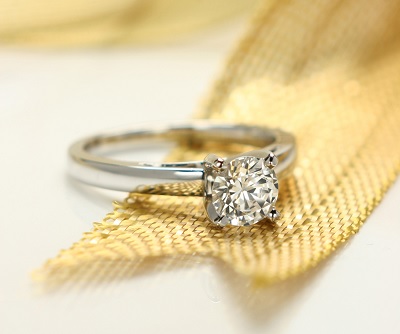
Can you see how the facets of the stone pick up color from the gold ribbon?
The facets of a diamond behave like “a series of mirrors” that reflect details of their surrounding environment. As a result, your choice of metal for the setting would directly affect the diamond’s appearance.
If you are buying a yellow gold ring setting, the good news is that you can have more leeway with lower color grades. This is because the color of the diamond is much more readily noticed when it is seated against a contrasting background.
If the stone is to be set in a yellow backdrop, the distinction would be far less noticeable as there is less contrast. In such scenarios, the yellow tinge of J-K diamonds would blend in better on yellow gold settings than it would on a white gold setting.
On the other hand, if you are color averse and want a white looking ring appearance, then common sense will tell you that you should buy a white gold or platinum setting.
Real life engagement rings with D color center stones in identical settings.
In the examples above, I want to bring your attention to the yellow gold diamond ring. Can you see that the internal reflections actually look yellowish compared to the other diamond in the white gold setting?
If you placed a D colored diamond in an 18k yellow gold setting, the icy white color of a D would now turn into a J or K hue. In my opinion, this would be a waste of money and defeats the purpose of buying a D diamond in the first place.
Furthermore, the D colored diamond may also look “awkward” in a yellow gold setting due to a palatable difference in color.
Where From Here? How Should You Choose a Suitable Diamond Color?
When shopping for engagement rings, one of the most common misconceptions that shoppers have is the belief that colorless (D-F) diamonds exhibit better brilliance than lower colored diamonds.
In reality, the deciding factor that determines the beauty of a diamond lies in its cut quality and not the color it has.
If you are a practical person like I am, there’s no reason to be spending more money on an attribute (color) that your eyes cannot appreciate. Instead, you might want to consider spending your budget on a higher carat size where its visual impact would be far greater.
In order to get the maximum bang for your buck, I recommend buying near-colorless diamonds (e.g, G-H range) as they would usually appear colorless to the naked eye. This should enable you to save a ton of money instead of buying one in the D-F range.
Next, if you are wondering how different colored diamonds look like, you are going to enjoy reading the following page. I am going to show you real life side-by-side comparisons of diamonds with various colors.
Related Articles
Leave A Comment

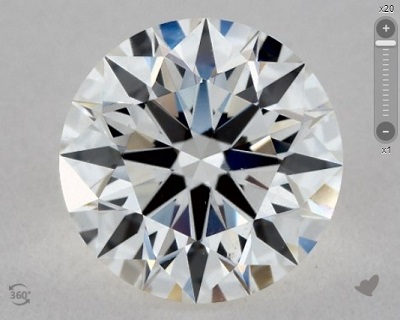
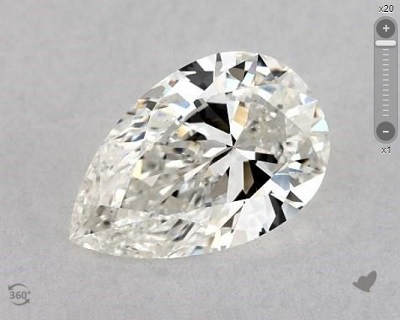
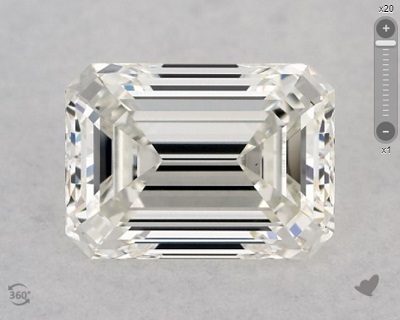
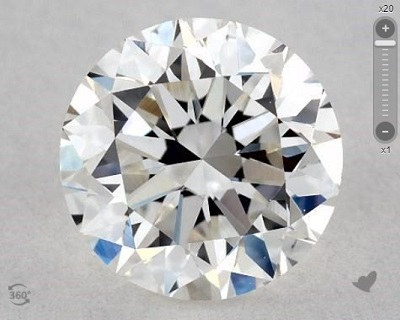
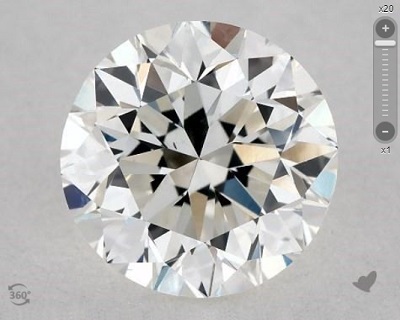
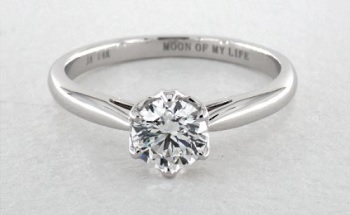
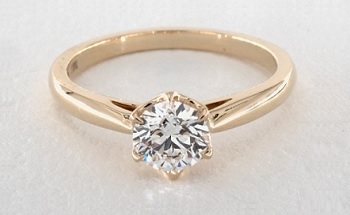
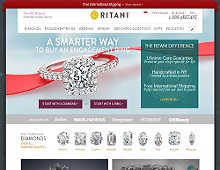
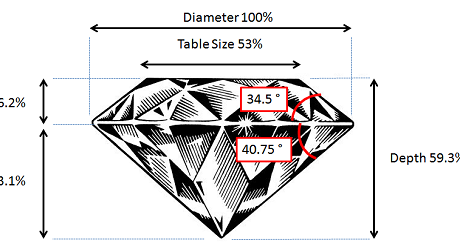
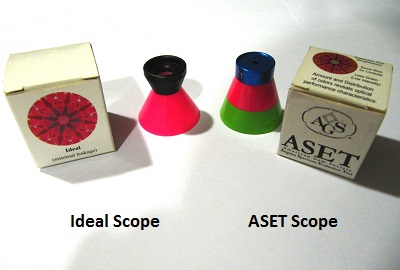
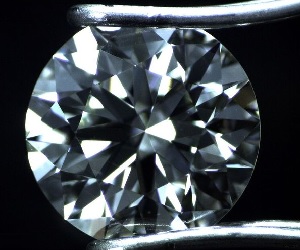









6 Comments
I’m wondering why does my diamond look yellow in certain light conditions. How do I make the diamond ring look whiter? I have a 2 carat size pear diamond ring.
I’ve told my husband to look at the ring but he says it looks white to him. So, could this be an issue with me and how easily do people see color between the different grades?
What type of lighting did you view your diamond in? If you viewed it in warm lighting, of course it would look yellow. If you looked at it in neutral lighting and your diamond is in a white setting, then your diamond’s color grade is probably too low for your needs.
I would also add that the color concentration in a 2 carat pear shaped diamond would be more pronounced at the tip of the stone and it could also be a reason for you to pick up some color with your eyes.
In general, the untrained eye cannot tell the difference between 2 diamonds that are one or two color grades from another. For example, from D-E or G-I or F-G. In fact, most people can’t tell diamond color grades apart until they are at least 3 to 4 grades away from each other in a side by side comparison.
I don’t know if I will ever see if anyone will respond to this, because I always forget where I’ve been visiting, but, I have a question about your comments about using yellow gold settings for diamonds. I realize that using yellow gold prongs might affect the “face up” coloring of the diamond, but, what about two toned settings, yellow gold ring with white metal prongs, would that still affect the color of the diamonds? I’ve had a couple of engagement rings that were yellow gold with white metal prongs, and the diamond always seemed to pop against the yellow gold, as opposed to blending in with the all white metal engagement rings. What I was wondering is, is the article referring to all yellow gold ring settings, with both yellow gold band and yellow gold prongs or both that and the two toned engagement rings?
Thanks for your comment. The article is referring to full yellow gold rings (i.e. yellow gold shanks + yellow gold prongs). 2 toned engagement rings will have the color of their metals reflected within the diamond as well. As for the other design where a white gold or platinum head is used in conjunction with a colored metal setting, the diamond will face up whiter. The purpose of using white colored prongs is for people who want a diamond to look whiter in a colored setting.
It’s an oxymoron when people do things this way. The white colored prongs are going to help but not by much. When you see a diamond pop in a setting, it’s likely due to the effect of cut quality and sparkle instead of being a result of setting the diamond ring in a yellow gold setting.
So, if you are thinking of how to make a diamond look less yellow, you should select a well cut diamond and place it in a white color setting.
Hi Paul,
If you were impartial to a rose gold setting vs a white gold setting for an H coloured diamond, would you do rose gold or would you do white gold, just for the fact that the diamond will appear whiter? And if white gold, would it be that much whiter to an untrained eye?
Go for white gold if you want a diamond that looks whiter. The surrounding of the diamond affects its perceived color as it gets reflected by the diamond’s facets.